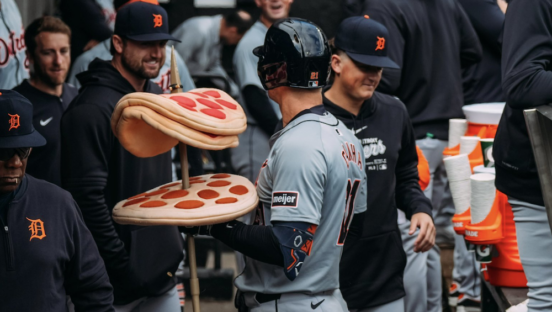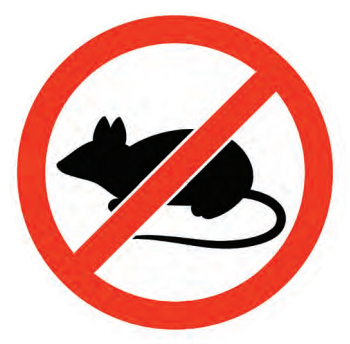 Here are some stats that may change the way you think about pest control: According to Cornell Hotel and Restaurant Administration Quarterly, consumers are four times more likely to tell friends they spotted a cockroach in a restaurant than they are to rave about a restaurant’s cuisine. Furthermore, the Weber Shandwick Safeguarding Reputation survey reports that reputation can account for as much as 63% of a company’s market value. Finally, did you know the Center for Disease Control reports that worldwide, rats and mice spread more than 35 diseases, including salmonella, E. coli and dysentery?
Here are some stats that may change the way you think about pest control: According to Cornell Hotel and Restaurant Administration Quarterly, consumers are four times more likely to tell friends they spotted a cockroach in a restaurant than they are to rave about a restaurant’s cuisine. Furthermore, the Weber Shandwick Safeguarding Reputation survey reports that reputation can account for as much as 63% of a company’s market value. Finally, did you know the Center for Disease Control reports that worldwide, rats and mice spread more than 35 diseases, including salmonella, E. coli and dysentery?
The risks posed by pests are clear. A single pest infestation could potentially damage your reputation, destroy valuable inventory or, in the worst case, close you down. Yet, as a restaurant owner, your pest program may not be at the top of your list of to-dos. Fortunately, there are things you can do as part of your regular operations to help you avoid pest problems before they damage your brand, your business or your bottom line.
Common Pests in Foodservice
The most common pests found in the foodservice industry include cockroaches, mice, rats, filth flies, small flies and ants. By having a general understanding of the biology and behavior of these pests, as detailed here, you can notice the first signs of pest activity and take measures to prevent them from impacting your business.
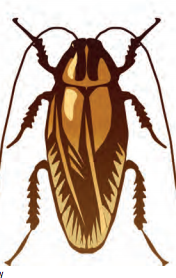 Cockroaches: The most common breed of cockroaches found in foodservice facilities is the German cockroach. Adult German cockroaches are about ½” to ⅝” in length and light brown in color, and have two dark bands on the shield just behind the head. German cockroaches like warm, moist areas, so kitchens are a desirable habitat. These pests are capable of feeding on a variety of materials and are prolific breeders. A single pair of breeding cockroaches can infest your facility with more than 1 million offspring in less than one year. They leave small fecal matter in areas they infest, staining surfaces such as walls or ceilings. Typically nocturnal, German cockroaches can be seen in daylight when first introduced into a facility or if the infestation is heavy. Another breed of cockroaches seen in foodservice facilities is the American cockroach. Although largely an outdoor pest, American cockroaches can find their way into restaurants through cracks and crevices, or even drain lines. Adult American cockroaches are about 1⅜” to 2⅛” in length and a reddish brown color, with fully developed wings. They are organic feeders and prefer fermenting food. Typically, you will find them along floors and in areas around drains or close to the exterior.
Cockroaches: The most common breed of cockroaches found in foodservice facilities is the German cockroach. Adult German cockroaches are about ½” to ⅝” in length and light brown in color, and have two dark bands on the shield just behind the head. German cockroaches like warm, moist areas, so kitchens are a desirable habitat. These pests are capable of feeding on a variety of materials and are prolific breeders. A single pair of breeding cockroaches can infest your facility with more than 1 million offspring in less than one year. They leave small fecal matter in areas they infest, staining surfaces such as walls or ceilings. Typically nocturnal, German cockroaches can be seen in daylight when first introduced into a facility or if the infestation is heavy. Another breed of cockroaches seen in foodservice facilities is the American cockroach. Although largely an outdoor pest, American cockroaches can find their way into restaurants through cracks and crevices, or even drain lines. Adult American cockroaches are about 1⅜” to 2⅛” in length and a reddish brown color, with fully developed wings. They are organic feeders and prefer fermenting food. Typically, you will find them along floors and in areas around drains or close to the exterior.
Mice: The house mouse is the most commonly encountered breed found in foodservice. Adult mice weigh about one ounce and are dark gray in color. These pests can enter through cracks as small as ¼”. Signs that there are mice in your facility include gnawing marks on packaging, tracks/footprints, and small pellet-shaped fecal matter about ⅛” long in areas they infest.
Roof rat: Seen mostly in warmer climates, a roof rat is 6” to 8” in length, with a tail longer than its body. These pests are frequently in high areas and can access a building through the roof from nearby trees. Roof rats prefer fruits and vegetables but are capable of feeding on a variety of material. They leave fecal matter about ½” in length, as well as “rub” marks from the oil in their coats. They are very effective climbers, and capable of crawling up and down walls.
Norway rat: The largest of the rat species, adult Norway rats can be 16 ounces or more and 7” to 9” in length, not including the tail. They burrow around buildings and find their way inside, searching for food. Prolific gnawers, they can also chew their way into facilities as well. They leave fecal matter approximately ¾” in length in areas they frequent, as well as “rub” marks from the oil in their coats.
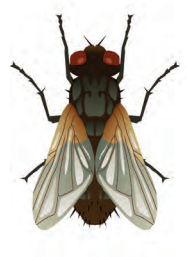 Filth flies: Filth flies, house flies, blow flies and bottle flies are the most common species of flies that infest food facilities. About ¼” in length, they feed on organic material. They are often attracted to bright light and enter facilities through open doors or windows. Once inside, they can be found anywhere, day or night.
Filth flies: Filth flies, house flies, blow flies and bottle flies are the most common species of flies that infest food facilities. About ¼” in length, they feed on organic material. They are often attracted to bright light and enter facilities through open doors or windows. Once inside, they can be found anywhere, day or night.
Small flies: Small flies, such as red-eyed fruit flies, drain flies and phorid flies, are a common nuisance in food handling establishments. Adult fruit flies are about ⅛” in length with bright red or dark red eyes. Because they require moisture, these pests live and breed in drains and around decaying organic material, as well as fruits and vegetables.
Ants: There are a variety of ant species, ranging from very small (⅛” in length) to large (½”). They are foragers and will find their way into structures through small openings. Capable of climbing, they may enter a facility through walls, roofs, cracks and crevices. Ants typically follow a trail, and you will see several marching to areas in search of food.
What You Can Do
Pests typically seek food, shelter and water. Therefore, in order to prevent most pests, you need to maintain the highest sanitation procedures and quickly address structural issues. Following are suggestions of steps you can take to help prevent pests from becoming a problem in your facility. Many of these items are probably already part of your daily routine, but it is important to keep them at the top of your mind, as well as educate your staff, so that you can keep pests out of your facility.
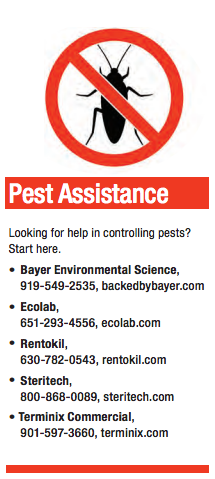 Sanitation: Maintaining the highest standards of sanitation is the No. 1 thing you can do to prevent pests—and it’s also good for business. According to Restaurant Hospitality, more than 60% of guests rate cleanliness as their No. 1 consideration when choosing a restaurant. Here are specific steps you can take to help keep pests out and keep guests returning:
Sanitation: Maintaining the highest standards of sanitation is the No. 1 thing you can do to prevent pests—and it’s also good for business. According to Restaurant Hospitality, more than 60% of guests rate cleanliness as their No. 1 consideration when choosing a restaurant. Here are specific steps you can take to help keep pests out and keep guests returning:
• Clean under equipment all the way to the walls to catch any hidden trash and food debris
• Clean hidden areas where water and food are often overlooked and can accumulate, such as under the cook line, cracks, crevices, inside counter equipment or around drains
• Vary your cleaning routine in direction and intensity. The same people using the same cleaning method day after day can result in missed areas and hidden sanitation issues
• Don’t use high-volume water pressure to clean floors and lower walls, as this can push water and food particles into wall voids, under floor tiles, and other areas where pest activity can flourish. Pressure washers can also damage floor tiling.
• Ensure that no water is left standing; drain sinks after use and dump out cleaning buckets or mop buckets after use.
• Help decrease damp areas by directing gutter and air conditioner drains well away from the building to prevent excess moisture around the perimeter.
• Clean drains and traps weekly, using an industrial drain cleaner and a stiff long-handled brush.
• Use a “snake” device in clogged drains to clean out all gelatinous material.
• Keep stored food in sealed containers.
• Keep garbage cans tightly covered at all times and remove garbage as needed throughout the day. Empty all garbage cans at the end of the day—never leave trash inside the facility overnight.
• Vacuum or sweep up any food spillage immediately. Make sure to sweep under shelving.
• Keep employee areas clean and clear. Make it standard practice for employees to clean up after themselves when eating in exterior break areas. If present, locker rooms should also be well-maintained.
• Store all garbage and recycling outside and as far from the building as possible to keep flying insects (which will be attracted to your garbage) away from the entry points of your facility.
Structural: Pests can enter your facility through the smallest gaps and holes, then hide and breed in tiny cracks and crevices you may not even be aware of. In fact, rodents can enter your facility through holes and cracks as small as ¼” high. Here are some things you can do to prevent pests from entering your facility:
• Look for any openings or holes, both on the interior and exterior of your facility, and seal them to prevent pest entry.
• Pave or seal the area beneath and around dumpsters.
• Install commercial-grade door sweeps.
• Keep all exterior doors and windows closed as often as possible.
• Equip all windows with properly fitting screens.
• During delivery pickups by staff, don’t allow doors to be propped open for extended periods of time.
• Seal structural cracks and voids that could allow the accumulation of food spillage; this includes cracks or breaks in tile.
In addition to all of these actions, work jointly with your pest management provider (PMP). Your PMP can perform a thorough inspection of your facility’s interior and exterior and alert you to sanitation and structural issues that could contribute to pest infestation. They may also offer an on-site staff education session and materials to help keep best pest practices at the top of your mind. As a full team working together, you can protect your guests, staff and business from the harmful damage done by pests.














